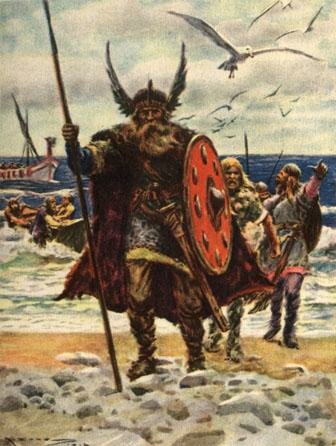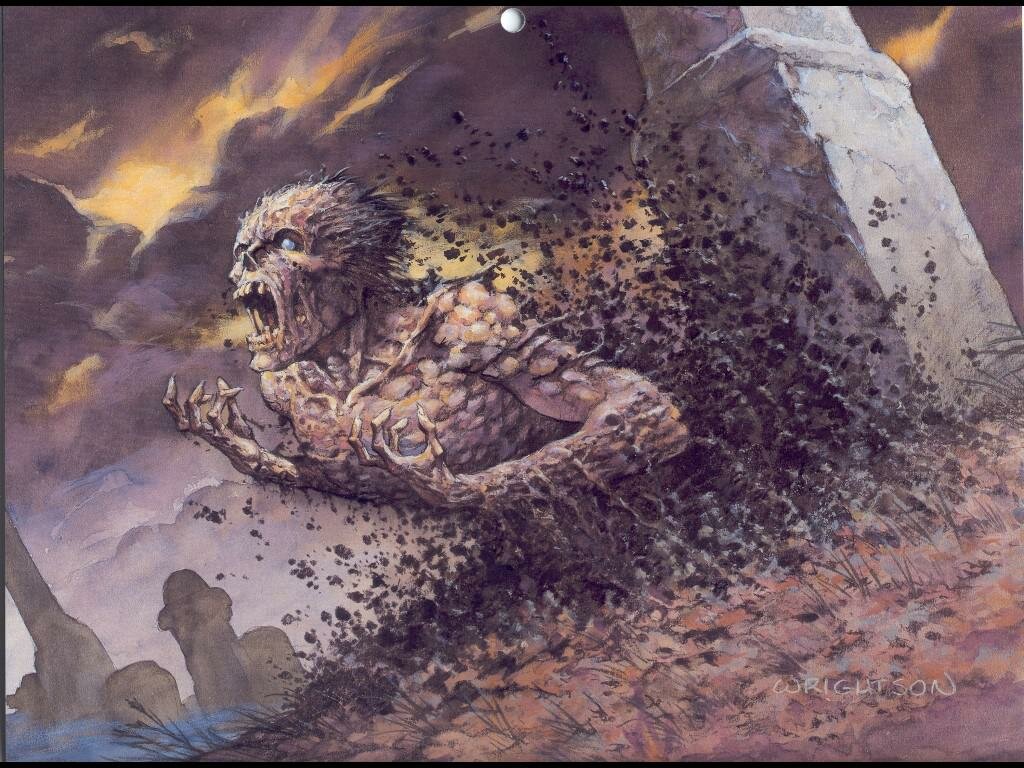Top 10 Nature’s Greatest Creations
Suggested by SMSIf you believe that nature is dull, think again. Our world is home to some incredible creatures and its history is filled with some truly awesome beasts. Animals of immense size or minute complexity, brutal killing machines and efficient biological machines, all have had their chance to compete here for the title of nature’s greatest creation.
The creatures have been judged on their prowess, their incredible attributes and their success as species.
10. The Malheur National Forest Fungus

This fungus is so large that it has claimed the title of the largest organism on the planet. Whilst the Great Barrier Reef is actually a collection of separate organisms, this fungus is linked underground effectively making it one huge mushroom. It is so large that it spans 9 square kilometres (2,200 acres) of the Malheur National Forrest in Oregon. On the surface, this vast fungal colony is not so impressive to look at, sprouting only small visible mushrooms, but belowground it is the largest fungal colony in existence.
9. Paraceratherium

The largest land mammal in history, the Paraceratherum lived in Asia around 20 million years ago. At seven and a half meters (25 ft) tall they were larger than any species of mammoth and weighed as much as an average sized sauropod dinosaur. This height was used to take leaves from the tops of trees in the lush forests in which they lived.
Despite appearing to be something of a cross between an elephant and a giraffe, Paraceratherum were actually related to rhinos. Many believe that they would have carried the same thickly armored hides as their modern progenitors, making them both big and tough. During their time on earth there were no predators capable of taking down this massive beast.
8. The Cockroach

Ah, the cockroach, one of the humblest of nature’s creations. It’s hardly the most beautiful creature on Earth, nor the smartest or the most fearsome predator. But it is a survivor.
It is widely believed that cockroaches are capable of surviving a nuclear war. Whilst they are not as resistant to the effects of radiation as some other insects, it is true that they are fifteen times more resistant than humans. Cockroaches also have other amazing abilities, like being able to go without oxygen for up to 45 minutes. They can also survive without food for a month and are capable of eating almost anything, including the glue on the back of stamps. It’s not pretty but if it works don’t knock it.
To date, around 4,000 distinct species of cockroach have been identified.
7. Hadrosaurs

The term Hadrosaur refers to members of the Hadrosaurid family of dinosaurs. There are several distinct species of Hadrosaur, which results from the incredible success of Hadrosaurs throughout the age of the dinosaurs. Hadrosaurs became the most common family of dinosaurs and lived in huge herds across the world. They were preyed upon by many carnivorous species but their numbers rarely diminished. Because of this they have been called the cattle of the dinosaur era.
The incredible success of the Hadrosaur comes from the unique jaw structure by which they can be identified. Hadrosaur jaws were elongated and flat, leading to the nickname ‘duck billed dinosaurs’. These contained literally thousands of teeth and were perfect for chewing plants. Combined with a long digestive tract, stored between the hallmark wide hips, this made hadrosaurs capable of eating plants that other dinosaurs could not, particularly waxy needles. Hadrosaurs are also thought to have eaten rotten wood to extract the nutrients of the fungus living inside. Other dinosaurs relied largely on stomach stones to digest their food but with chewing down to an art, Hadrosaurs had the energy needed to outrun its predators. They also sought safety in numbers, living in large herds. Some scientists speculate that these would have stripped an area clean of plant life before moving off.
Hadrosaurs varied greatly in size. Most were capable of walking on either two or four legs and could lift themselves on their larger back legs to reach higher food sources. The major difference between Hadrosaur species is the presence (or lack of) a cranial crests, protruding from the backs of their skulls. These were thought to be decorative and sexual in function, hence their variation between species of Hadrosaur.
Hadrosaurs have also been called ‘bird hipped’ dinosaurs as they share a common hip configuration with birds. The Hadrosaur family was not one of the species that evolved into modern birds but this was crucial in proving the common ancestry between dinosaurs and modern birds.
Hadrosaurs were most common during the Cretaceous era (which is when their evolved eating habits and digestive capabilities would have been most useful) when their numbers would have been in the billions.
6. The Terror Birds

Sounds ridiculous, right? Birds were only ever scary in the Alfred Hitchcock film and hardly then. But believe it or not the dominant predators in South America for 60 million years were in fact birds. Giant, 10 foot tall, flightless terror birds. It is thought that terror birds evolved from the dinosaurs and hunted the plains and forests of South America from shortly after the fall of the dinosaurs to only two million years ago. These birds also spread into North America and the largest specimen has been found in Texas. In 2006, a skull was discovered in Patagonia. This skull is believed to belong to a previously unknown species of terror bird, and scientists predict that it would have been capable of swallowing an averagely sized dog.
Terror birds were big, vicious and fast. Although scientists cannot be sure, they estimate that the larger of the terror birds would have been capable of speeds in excess of 30 miles per hour.
South America was not the only place to have been home to giant birds. Aside from the Ostrich and Emu, Australia has been home to many large birds throughout history. These would have no doubt been encountered by the early inhabitants of the area. In New Zealand, early Polynesian settlers came across the Moa, twelve foot tall, herbivorous birds. Amazingly these lasted until around 1500, when they were hunted to extinction. Unbelievably, until the arrival of the Maori, the Moa were hunted by a species of giant eagle. The Haast’s Eagle had a wingspan of ten feet and was the largest eagle to have ever lived.
5. Tyrannosaurus Rex

The Tyrannosaurus Rex or T-Rex was one of the largest carnivorous dinosaurs and, as such, one of the largest land predators to have ever existed. The name means ‘tyrannical lizard king’ and has helped in the public perception of the T-Rex as the most badass of all the dinosaurs. It is widely believed that the T-Rex was natures greatest ever predator, although some now believe that it was actually a very large scavenger.
Members of the Tyrannosaurus family have been found all around the world but the T-Rex lived particularly in what is now western North America. They would have lived alongside Ceratopsians, such as the Triceratops. They would most likely have preyed mostly upon large herds of Hadrosaurs, although some believe that all Tyrannosaurids were primarily scavengers. Tyrannosaurs are considered to be unique amongst carnivorous dinosaurs for their tiny forelimbs, huge skulls and short snouts.
The Tyrannosaurus Rex was the largest of the Tyrannosaurids. The largest specimen ever discovered measured 12.8 meters (48ft) long and 4 meters (13ft) tall at the hips. The largest T-Rex skull is 1.5 meters (5ft) long and the largest tooth is 30 centimeters long (including the root), the longest tooth of any dinosaur. Despite it’s size, the T-Rex was also an incredibly fast creature, although scientist debate exactly how fast.
The T-Rex lived in the late cretaceous period, meaning that it was around for the big extinction that wiped out almost all of the dinosaurs.
4. Spinosaurus Aegyptiacus

The Spinosaurus Aegyptiacus was a large carnivorous dinosaur, distinguishable for its crocodilian jaw and the large sail believed to have protruded from its back. This sail was supported by bone protrusions from the vertebrae and may have been used as a sexual display, similar to a peacocks tail. As such it may have been brightly colored or flushed with blood.
The Spinosaurus lived in North Africa and, at 16-18 meters (52-59ft) and weighing up to 10 tons, is the largest carnivorous dinosaur ever discovered. As such it is possibly the largest carnivorous land animal to have ever existed. It is believed that it died out in the early cretaceous period. However, a lack of evidence makes any supposition about this creature difficult.
The Spinosaurus Aegypticus (or ‘Egyptian Spine Lizard’) was discovered by German paleontologistErnst Stromer who unearthed its skeleton in the Egyptian desert in 1912. Unfortunately, many of the bones were damaged in transit to Germany and later the remaining bones were destroyed by an Allied bombing raid during World War II. The lack of material evidence pertaining to the Spinosaurus, combined with its unlikely size and appearance, has cast doubt over its existence for many years. However, recent finds in Morocco are believed to be of the same species or a closely related subspecies.
3. The Crocodile

The crocodile is the oldest living predator in existence. It has survived for millions of years, unchanged since the time of the dinosaurs and is still considered to be one of the most lethal killers in nature. The fact that it has barely evolved at all in millions of years is proof that it’s design is so perfect and so efficient that it cannot be improved upon. Crocodiles are essentially a trap animal, like most spiders. They lay in wait for their prey, meaning that they need expend no more energy than is necessary. It is probably this strategy that allowed them to survive the extinction events that wiped out the dinosaurs, and to survive the cold of the ice age too.
In their 200 million years, the only way in which crocodiles have changed is their size. Some members of the crocodile family have adapted to be smaller than others, the alligator included. This is a common trend. Millions of years ago there would have been many other larger species of crocodile. The largest recorded modern crocodile was approximately 25 feet in length, but fossil records show that they were once much larger. Crocodiles and Alligators are found across the globe, wherever a suitable habitat can be found.
2. Mankind

It would be naive not to think that mankind is not one of nature’s greatest creations. However it would be equally naive to think that humans are the greatest creature to ever walk the earth. Relatively speaking, mankind is a new addition to the Earth and, although we have made great advances in almost every field, we have yet to prove ourselves in the greater scheme of things. Scientific learning and artistic expression are very interesting and all, but they are unlikely to save you in a battle against a T-Rex. Advanced weaponry is a huge step forward, granted, and has been mans best friend ever since the development of the spear. But can it really compare to some of natures other great creations?
Of course mankind is a great species. How could we describe ourselves as anything but? We have the ability to predict the weather, to alter the landscape and to travel to other worlds. We are also now on the verge of creating other forms of life, by means of genetic manipulation and advanced robotics. But nature is about one thing and one thing alone: survival. We are the first species to have the ability to destroy ourselves and that surely can’t be a good thing. As we have become more advanced we have also become more fragile, becoming too dependent on our complex society and complex technological systems. It is widely believed that something as simple as the breakdown of our communication infrastructure could doom us to extinction. For all of our advances can we really say that we could withstand the natural disasters that other species have faced? Can we say with certainty that we will still exist in several million years time, unaltered and still kicking ass like the crocodiles? Only time will tell.
One consolation is that if mankind does become extinct, we will leave behind a legacy in the form of our great buildings and monuments. However, recent thoughts on this matter are that within one thousand years of mans extinction, almost all evidence of our civilization will have crumbled away. Buildings will crumble, cars will rust and nature will simply get to work on it’s next great innovation.
Mankind is great, yes, but by no means are we eternal.
1. Ants and Termites

Despite common belief, ants and termites are not closely related. Both live in complex social structures and have evolved into cast systems, comprising of workers, soldiers and breeders. But despite their similarities, ants are actually more closely related to wasps than they are to termites. However, the two species are both categorized in the order Hymenoptera because of their tiered social structure. Ant colonies typically have only one queen capable of breeding but termites often have an entire army of breeders.
Whilst ants have clearly won the turf war between the two, termites are clearly the greatest builders. Their nests are usually built in the branches of trees and form into mounds over time. Some termite mounds are built in ingenious sail, or gravestone shapes. These always face north-south so that the catch the morning and evening sun but stay cool during the day. Termite nests are specially designed so as to provide an air-conditioned effect, and to collect condensation for the termites to drink. Termite mounds also often contain special chambers for growing fungi. Some species of ant also farm fungus and will collect leaves for the fungus to absorb. Termite colonies can contain thousands, sometimes millions of termites. They can be compared to huge, eco-friendly and perfectly ordered cities.
Some ants also farm caterpillars. The caterpillars are herded to feeding areas during the day and are kept inside the ants nest at night. They produce honeydew when massaged by the ants. A similar relationship exists with some aphids, who produce a sugary substance on demand when tapped by the ant’s antennae.
With ant and termite populations around the world being so high, and their civilizations being so perfectly evolved, it could be said that it is these species that truly rule the world. As farmers, scavengers and hunters they are highly skilled and can find food in even the most desolate of environments. Vast armies protect their colonies from invaders and even larger armies of workers are capable of acting as one large organism. When the different castes of ant and termite work together there is nothing they cannot achieve.










The BBC production of the primative world from 3 million years ago to l0,000 years is a fantastic event. The terrior bird has a charming bunch of feathers on its head, almost like a pert little cocktail hat
I was very pleased to see ants top the list – well done overall.
i think mankind is the best….
“When the different castes of ant and termite work together there is nothing they cannot achieve.”
Nothing!?! Holy hyperbole, batman! This author believes that insects can split the atom and send robots to Mars with enough cooperation.
Mankind can’t do either of those things!
"However, the two species are both categorized in the order Hymenoptera because of their tiered social structure."
Ants belong to Hymenoptera, the largest order of insects
Termites belong to Isoptera, and are the only members of that order
"Nothing!?! Holy hyperbole, batman! This author believes that insects can split the atom and send robots to Mars with enough cooperation.
Mankind can't do either of those things! "
Well, first off, there are human-made rovers on Mars and we've split the atom ages ago, so I am either misunderstanding you, or you're just THAT ignorant.
Also, those Mars rovers – if you look back far enough – were sent there what originally was lumps of atoms.
"8. The Cockroach – It is widely believed that cockroaches are capable of surviving a nuclear war."
Well… I really I don't think so, but whenever I spray a toilet bowl cleaner to the cockroach, they just die instantly. Is it means that a "Toilet Bowl Cleaner" is powerful than a Nuclear Bomb? OMG! I wish the military won't discover and make a horrible "Toilet Bowl Cleaner Bomb."
Then that means toilet bowl cleaner is stronger then raid and other insect pestiides
The pycture you used for Tyrannosaurus rex is actually the fictional Vastatosaurus rex from King Kong, a different genus. Also, it is improper to hyphenate T. rex.
*picture
I've never seen a terror bird
i have never seen a cockroach the size ov a hand